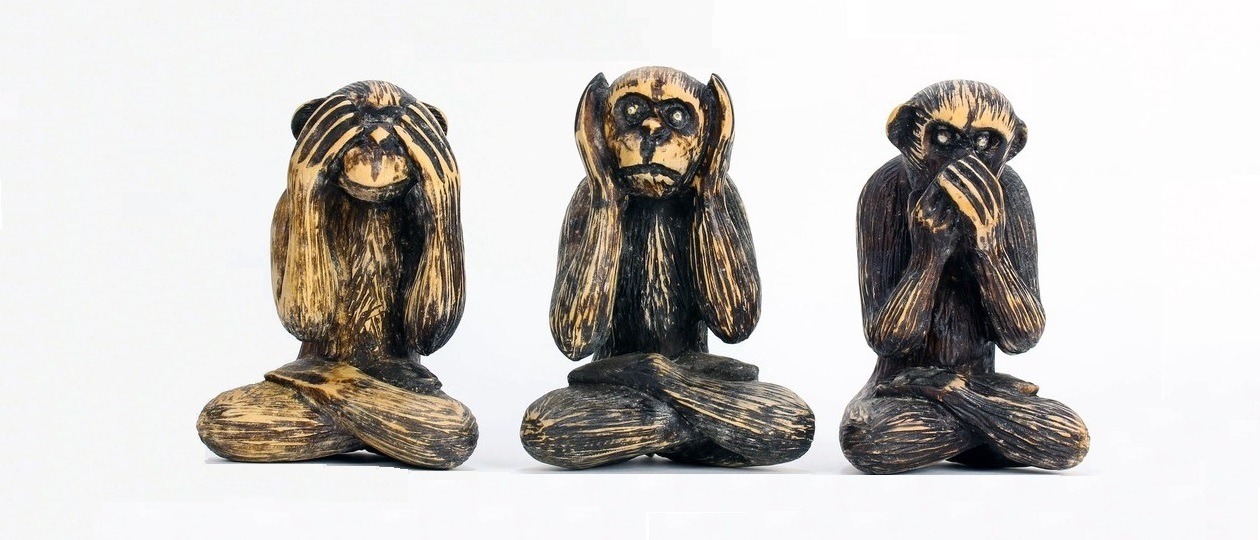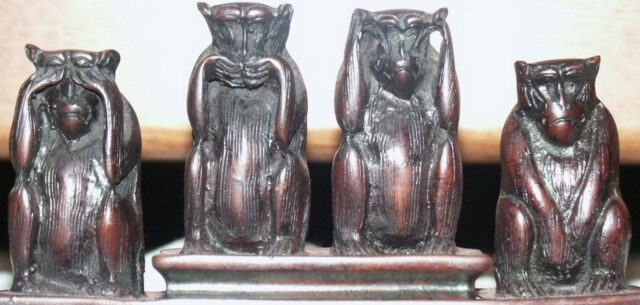
“Do not look at what is against the rules, do not listen to what is against them, do not say what is against them” – Confucius (孔子 Kung Tzu), “Conversations and Judgments” (論語 Lun Yu).
In many countries of the world, today it is customary to give friends and relatives as a sign of a wish for longevity and health a souvenir figurine of three monkeys covering their eyes, ears and mouth with their paws, or their image.
It is believed that the three sacred monkeys are the companions of the blue-faced deity Shomen Kongo (青面金剛), who protects people from spirits, demons and diseases. But where and how did this amazing allegory come about?
Most Oriental researchers agree that such a popular monkey composition originated in Japan, since the scientific assumption about its “birthplace” is fully confirmed by the discovered cultural artifacts and the linguistic analysis carried out.
The most common is a simplified and at the same time erroneous interpretation of the symbolic composition Sanzaru (三猿) of three monkeys – I don’t see anything, I don’t hear and I don’t speak. However, first of all, this is the Eastern embodiment of the religious and philosophical doctrine of observance of moral and ethical integrity.
It is necessary to clarify that this philosophical concept consists in the idea of human invulnerability and protection of the whole society from evil in case people learn not to pay attention to its manifestations, they no longer speak and hear anything bad, which, of course, is now in itself looks rather utopian and does not fit well with the usual phenomena of life everywhere, including modern Japan.
It is interesting that the relation “I don’t see, I don’t hear, I don’t speak”, expressed in such a graphic way, being written in the characters 見猿、聞か猿、言わ猿 or 見ざる、聞かざる、言わざる – mizaru, kikazaru, iwazaru, includes an action verb with archaic suffix “-zaru”, which gives a negative meaning. And the suffix itself is consonant with the word “monkey”, pronounced as “saru” (猿), and, therefore, the well-known monkey composition is the embodiment of a pun or a play on words that is obvious only to the Japanese.
However, the very plot of the “three wise monkeys” has spread far beyond the Land of the Rising Sun and is reflected in modern culture, it is also preserved in painting, in particular in the ukiyo-e genre.
And by the way, in some cases, the group is supplemented by a fourth monkey covering its crotch. This symbolizes the principled stance of “do no evil” – shizaru (しざる), but it is not very popular, since in Japanese and Chinese the number “4” is pronounced the same as the character for “death” (死) – “shi”, and therefore considered unlucky.

The oldest images of three monkeys studied by scientists were also discovered in Japan. It is most likely that the original composition was formed in the Japanese belief Koshin (庚申), which arose due to Taoism (道教) brought from China. In Chinese, the name of the teaching is pronounced as “geng shen”, and is reflected in detail in the canonical Taoist texts.
At first, the ritual practices of Koshin were mastered only by the Japanese court aristocracy – “kuge” (公家) and, only after gaining support from several branches of Buddhism, did they gain some distribution among the population of Japan.
To date, the tradition of the Koshin cult has hardly survived and has been transformed into local cultural reconstructions with the use of alcohol.
The magic of numbers has always been especially revered in the East, and as a result, the Monkey is not only an animal, but also a number, or, more precisely, one of the phases of the universal cycle. So, for example, in accordance with the cyclical alternation of phases, every twelfth day passes under the sign of the Monkey, and the hour of the Monkey in traditional Chinese calculus is considered to be the period between 15 and 17 hours. The monkey also occupies the ninth position in the cycle of the popular eastern “animal” calendar, where 12 animal symbols denote alternating years.
And if you add 10 “heavenly stems” associated with 5 primary elements to 12 symbolic animals, you get an even larger cycle of 60 phases. And since any natural events are cyclical, the development of all situations can be decomposed into 60 phases before the start of a new cycle. Cycles are divided into large 60-year and small 60-day cycles. The 57th day or year is considered the most unlucky. And this 57th phase is called “koshin” because “ko-” (庚) is one of the primary elements commonly called metal, and “-sin” (申) is monkey.
The doctrine of three worms living in the human body passed from China to the Japanese. These three mythological “entities” constantly tempt their carrier into committing various rash acts, and when the carrier falls asleep on the night of that very “monkey” day of koshin, they immediately go with a denunciation of his misdeeds to higher powers. And in order to prevent them from contacting the supreme deity, the followers of the Koshin cult in Japan and Geng-shen in China organized nightly collective vigils every 60 days.
The three monkeys gained their original fame in Nikko (日光), one of the historical religious and cultural centers of Japan. Nikko’s most famous attraction is Tosho-gu (東照宮), a Shinto shrine known for its intricate carvings.

The images of monkeys do not even decorate the central building of the sanctuary complex, but only its stables. Moreover, the carved panel with the composition “I don’t see, I don’t hear, I don’t speak” is not the only one, but among the various monkey poses, the Japanese singled out precisely these three figures. Since then, it has been the benchmark for the composition of the most famous three monkeys in the world, and any such symbolic group is often called “The Three Monkeys of Nikko”.
In historical terms, the monkeys from Nikko are interesting in that they indicate a very specific time limit for the appearance of the symbol. The construction of the stable with its decorations is confidently attributed to 1636, which means that at that time there already existed a single composition of three monkeys.
However, it is theoretically possible to transfer the time of the appearance of the three monkeys by another 1-2 centuries before their depiction in Nikko.
And in the surviving legends, the name of a Japanese who lived in the 8th-9th centuries and was the first to depict a composition of three monkeys is even called, he is also credited with many other “discoveries” that have firmly entered Japanese culture.
This is the great teacher Dengyo-daishi (Saichō, 最澄), the founder of the Tendai branch of Buddhism, and he may well have brought the symbol of the three monkeys from China along with the teachings of the Lotus Sutra, tea and other things. But still, the legends remain legends, and the three monkeys seem to be a Japanese endemic rather than a symbol that sailed from the continent.
By the way, about the natural prototype of the three monkeys, we can confidently assume that if the symbol was born in Japan, most likely, the only species of monkeys living in the country, Macaca fuscata, or, more simply, Japanese macaques, is depicted.
In conclusion, it is important to note that the analogy of the stable semantic construction of the “see-hear-speak” prohibitions is found in many religious and philosophical teachings of both the East and the West. And the principle personified by the three monkeys is much older than the composition itself.






One comment
Adam Davis
30.09.2022 at 12:15
Hi! Your article on the symbolism of the three wise monkeys is absolutely amazing! It is so interesting to learn about the origins of this amazing allegory. I especially liked how you revealed the meaning of the symbols and their history. This review will definitely make me think about the philosophical aspects. Thank you for such a fascinating read!